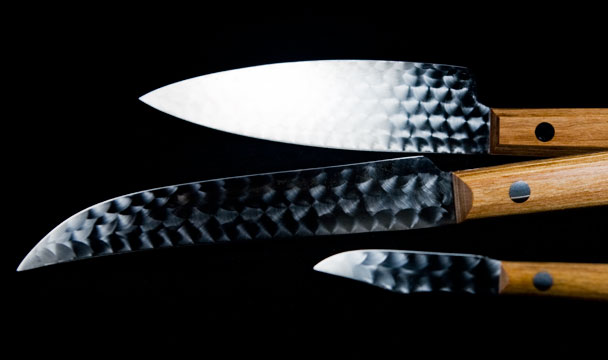When Ernest “Mooney” Warther discovered a dusty pocket knife on a dirt road in 1890, he not only set a course toward his own destiny at the tender age of five, but also laid a career path for four generations of his family to come. Located in Dover, Ohio, the Warther Museum and Knife Factory is part tribute to Mooney’s love of and phenomenal talent for carving (the Smithsonian has tried to buy some of his intricate hand-carved pieces; his family won’t sell), and part last-stand artisan craft shop: It has been making high-carbon steel kitchen knives for 106 years.
“We’re one of the last companies that still grind the knives by hand,” says Mark Warther, 47, one of Mooney’s three grandchildren currently running both the museum and knife business in the original Swiss chalet-like buildings where Mooney started it all with his wife, Frieda, in 1902. After that first pocket knife and years of self-taught whittling using old soup bones as his medium, Mooney, who died in 1973 at the age of 87, began to work in ebony and ivory. He found, though, that these materials required a better type of tool than what was readily available. “My granddad worked in a steel mill, but he needed to supplement his income,” says Mark. “He also needed to find a knife good enough to carve the ivory and ebony, so he started making knives for himself and to sell to others.”
Although the line has grown to 17 kitchen and steak knives, it’s Mooney’s original design—a paring blade with an ingenious little hump added to the blunt side to keep your hand from slipping—that remains the best seller. And all knives are still made by hand. “Grinding the knives by hand enables you to create a very thin blade. We use Vanadium steel, and by tempering it very hard and grinding it very thin, you create a knife that cuts with little resistance,” says Mark. And as long as you pay the postage, the Warthers will sharpen your knife for free whenever you like, for the rest of your life.
The next wave of Warther kids are putting their own spin on things, adding Internet sales and bridal shows as new ways to compete in the marketplace, but the family refuses to allow the knives to be manufactured anywhere except the original 9-person Dover shop. “We see it as a legacy and a tribute to my great grandfather,” says Patrick Warther, 24, who along with his sister, Katie, her fiancé, Steve Cunningham (who is currently learning how to make the trademark swirl pattern on the knives), and cousin, Kyle, are the newest generation to embrace the family business.
Tours of the museum, which are often given by Mark, always end in the knife shop, where you can see blades being ground and sharpened through a glass-picture window that peers into the small factory. “One woman who went on the tour said to me, ‘I have to tell you something—I came through your front door kicking and screaming, but I didn’t know that I was going to see a great American love story,’” says Mark. “I thought that was a heck of a compliment.”
The Warther Carving Museum and Knife Factory, 330-343-7513, 331 Karl Avenue, Dover, OH, 44622, www.warthers.com.

